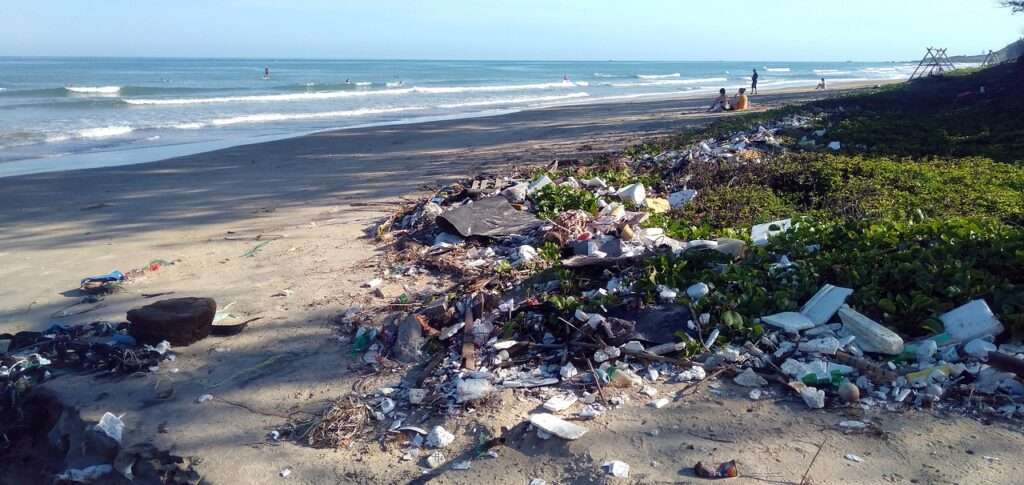
COMPETITIVE EXAM MCQs SERIES of ENVIRONMENTAL SCIENCE for UGC-NET/JRF, SLET, ARS, GATE, and other entrance tests – Environmental Pollution and Control – Radioactive, Thermal and Marine Pollution.
Syllabus Outline
- Natural and anthropogenic sources of radioactive contamination (e.g. nuclear power plants, mining activities, medical applications, and nuclear accidents).
- Types of radioactive pollutants (e.g. alpha, beta, and gamma radiation).
- Transport, fate, and bioaccumulation of radioactive pollutants in the environment.
- Effects of radioactive pollution on human health, ecosystems, and biodiversity.
- Sources of thermal pollution (e.g. industrial discharges and power plant cooling systems).
- Effects of thermal pollution on aquatic ecosystems (e.g. changes in water temperature, dissolved oxygen levels, and biodiversity).
- Role of thermal pollution in altering nutrient cycling and ecological processes.
- Sources of marine pollution (e.g. land-based runoff, industrial discharges, oil spills, marine debris, and atmospheric deposition).
- Effects of marine pollution on marine ecosystems.
- Types of marine pollutants (e.g. plastics, heavy metals, pesticides, nutrients, pathogens, and persistent organic pollutants).
This quiz contains the concept-based most frequently asked 25 MCQs of “Radioactive, Thermal and Marine Pollution“. Each question has a single correct/most appropriate answer.
*****
1. Which of the following is the primary cause of ionizing radiation that affects the activities of most enzymes?
a) Photoemission of electrons
b) Structural change of enzyme by α-particles, β- and γ-rays
c) Interaction of electrons with the body
d) Interaction of radiation with substrate
2. Which radioactive element is classified as an indoor pollutant?
a) Oxygen-16
b) Nitrogen-13
c) Carbon-14
d) Radon
3. Which of the following types of radiation has the highest penetration power?
a) Alpha radiation
b) Beta radiation
c) Gamma radiation
d) Neutron radiation
4. Which of the following organs is most sensitive to the effects of ionizing radiation?
a) Liver
b) Skin
c) Bone marrow
d) Kidneys
5. What is the primary pathway through which radioactive pollutants enter the human body?
a) Inhalation
b) Ingestion
c) Dermal absorption
d) Injection
6. What is the main environmental concern associated with radioactive pollution?
a) Acid rain formation
b) Ozone depletion
c) Global warming
d) Long-term health effects
7. In which unit radiation’s biological effect on living tissue is measured?
a) Roentgen
b) Gray
c) Sievert
d) Curie
8. What is the primary reason for long-term storage of radioactive waste?
a) To prevent radioactive decay
b) To reduce the risk of accidental exposure
c) To minimize baseline radiation levels in the environment
d) To promote the spread of radiation
9. What is the main factor determining the biological effects of radiation exposure?
a) Type of radiation
b) Distance from the radiation source
c) Duration of exposure
d) Individual susceptibility
10. Which aquatic organism is more sensitive to changes in water temperature caused by thermal pollution?
a) Phytoplankton
b) Zooplankton
c) Fish
d) Algae
11. How does thermal pollution affect dissolved oxygen levels in aquatic ecosystems?
a) It increases dissolved oxygen levels
b) It decreases dissolved oxygen levels
c) It does not affect dissolved oxygen levels
d) It causes fluctuations in dissolved oxygen levels
12. What is the primary mechanism through which thermal pollution can harm aquatic organisms?
a) Alteration of pH levels
b) Disruption of reproductive cycles
c) Increased sedimentation rates
d) Oxygen depletion
13. How does thermal pollution impact the efficiency of wastewater treatment plants?
a) It enhances treatment efficiency
b) It reduces treatment efficiency
c) It does not affect treatment efficiency
d) It increases the lifespan of treatment facilities
14. How does thermal pollution impact the behaviour of aquatic organisms?
a) It does not affect behaviour
b) It stimulates feeding activity
c) It disrupts migration patterns
d) It promotes territorial aggression
15. Which pollutant is commonly associated with thermal discharges from power plants?
a) Heavy metals
b) Pesticides
c) Pathogens
d) Mercury
16. What is the primary mechanism through which thermal pollution affects the reproductive success of aquatic organisms?
a) Alteration of hormone levels
b) Disruption of mating behaviour
c) Enhanced egg fertilization rates
d) Reduction in offspring survival
17. Which of the following is a potential consequence of thermal pollution on aquatic ecosystems?
a) Decreased evaporation rates
b) Increased primary productivity
c) Expansion of hypoxic zones
d) Promotion of biodiversity
18. What is the primary concern associated with thermal pollution in marine ecosystems?
a) Coral bleaching
b) Ocean acidification
c) Salinity fluctuations
d) Sea level rise
19. How does thermal pollution affect the dissolved oxygen levels in the hypolimnion of stratified lakes?
a) It increases dissolved oxygen levels
b) It decreases dissolved oxygen levels
c) It does not affect dissolved oxygen levels
d) It promotes algal blooms
20. Which of the following is a potential long-term consequence of thermal pollution on aquatic ecosystems?
a) Accelerated eutrophication
b) Restoration of natural habitats
c) Recovery of fish populations
d) Extinction of sensitive species
21. What is the primary form of pollution caused by excess nutrients in coastal waters?
a) Thermal pollution
b) Chemical pollution
c) Eutrophication
d) Radioactive pollution
22. Which of the following pollutants is commonly associated with ocean acidification?
a) Carbon monoxide
b) Sulfur dioxide
c) Carbon dioxide
d) Nitrogen oxides
23. What is the primary mechanism through which microplastics enter marine ecosystems?
a) Plastic usage and discharge due to marine fishery and coastal aquaculture
b) High-speed circulation of atmosphere and deposition on water surface
c) Surface runoff
d) Deep-sea mining and oil exploration
24. Which of the following pollutants is commonly associated with red tides?
a) Heavy metals
b) Oil
c) Harmful algal blooms
d) Plastic debris
25. What is the primary route of exposure for marine organisms to persistent organic pollutants?
a) Inhalation
b) Ingestion
c) Dermal absorption
d) Injection
*****
Previous: Soil Microorganisms and their Functions
Next: Characterization of Solid and Hazardous Waste
References
- Mann, Kenneth H. (2014) Introduction to Environmental Radioactivity, Academic Press, 2nd edition.
- Sharma, S. K. (2019) Pollution and Its Management, Khanna Publishers, 1st edition.
- Krishnamurthy, R. (2008) Thermal Pollution: Prevention and Control, New Age International Publishers, 2nd edition.

